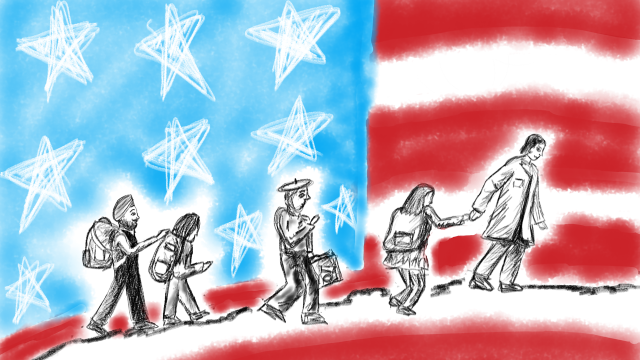
Title: Autocephaly, Geopolitics, and Russia’s Invasion of Ukraine
The Orthodox Church of Ukraine’s decision to permit parishes to celebrate Christmas on December 25 appeared to be a political ploy designed to diminish the influence of the Russian Orthodox Church in Ukraine. The Christmas decision is a small part of a larger story; Orthodox Ukrainians have been gradually distancing themselves from Russia for over a hundred years. Beginning in 2014, Russian aggression in Ukraine accelerated the process of Ukrainian Orthodox separation. The surprising intervention of the Ecumenical Patriarchate of Constantinople in Ukraine’s religious affairs created a new, canonical, and autocephalous (independent) Orthodox Church of Ukraine. This development, along with Russia’s full-scale invasion of Ukraine, has placed enormous stress on the extant Orthodox Church in Ukraine, which is subordinate to Moscow, and has exacerbated the strained relations among Orthodox Ukrainians with competing confessional loyalties.
Recently, mainstream media has featured the decision of the Orthodox Church of Ukraine (OCU) to allow its parishes to celebrate Christmas on December 25 instead of on January 7—a date that the OCU has shared with Russia’s Orthodox Church (ROC) for centuries in alignment with Eastern Orthodox tradition. Relatively recently in December 2018, a unification council created the OCU out of ecclesiastical territory in Ukraine traditionally endowed to the ROC. The process of its creation goes back centuries and is saturated with political controversy. The decision allowing communities to celebrate Christmas in the so-called “new” calendar appeared to be a political move aimed at detaching from Russia and the ROC’s conservative tendencies. The ROC has controlled Orthodox church practices in Ukraine since 1686. Since 1920, the leaders of the Ukrainian church independence movement have sought separation from the ROC, the right to govern their own affairs, cultivate native traditions, and pray in Ukrainian. Ukrainian churches rivaling the ROC kept reappearing from 1920 to 2017, and each time fellow Orthodox churches failed to recognize their legitimacy. This situation changed in 2018 when the Ecumenical Patriarchate of Constantinople (EP) created the OCU, which held jurisdiction over its internal affairs, conducted prayer in Ukrainian, and was eventually recognized by other Orthodox churches.
The EP oversaw the creation of the OCU by uniting the existing local Orthodox churches in Ukraine. Two of the most significant of these local churches were the Ukrainian Autocephalous Orthodox Church (UAOC) and Ukrainian Orthodox Church-Kyivan Patriarchate (UOC-KP). These two churches participated in the creation of the OCU and were integrated into it. On the other hand, the Ukrainian Orthodox Church-Moscow Patriarchate (UOC-MP)—which constituted part of the Russian Orthodox Church and was the largest Orthodox church in Ukraine—refused to join the OCU. The UOC-MP disagreed with the decision of its fellow churches to separate from the ROC and disputed the parishes’ property claims. In 2014, in response to Russian aggression in Donbas, Ukrainian parishes began transferring their affiliation from the UOC-MP to the UOC-KP. By 2019, over 500 parishes had transferred affiliation to the OCU, reflecting worsened relations between the churches.
In 2019, soon after the creation of the new Church structure, the OCU hinted at the possibility of permitting December 25 celebrations. This new orientation might not appear to be particularly groundbreaking, but its implicit message was that the OCU wanted to be a church of and for the Ukrainian people as opposed to one that performed Moscow’s bidding. Celebrating Christmas on December 25 was a departure from common Russian practice; however, the Church’s core intent was continuing of a century-long process of separation rather than a calendar alteration weaponized for political motives.
The creation of the OCU as an independent and legitimate Orthodox church increased pressure on the Moscow-aligned UOC-MP to distance itself from the ROC. Russia’s invasion of Ukraine in 2022 has further increased pressure on the UOC-MP to demonstrate its loyalty to Ukraine. Moreover, the Ukrainian government’s recent decision to restrict the UOC-MP’s access to Ukraine’s most holy shrine reveals newly-sparked tensions creating new fissures among the Ukrainian people.
The History of Ukrainian Church Independence
The Ecumenical Patriarchate of Constantinople (EP), which is the “first among equals” and the highest spiritual leadership of all Orthodox churches, originally initiated the process toward independent Orthodox practice in the nineteenth and twentieth centuries. When Ukraine attempted to create an independent republic in 1917-1921, leading bishops and theologians of the Orthodox Church pushed for the creation of an independent Church—particularly in ethnically Ukrainian parts of Poland, German-occupied Ukraine during World War II, and among the Ukrainian diaspora during periods of Soviet persecution of the Church. In the late 1980s, General Secretary Gorbachev’s policies of glasnost and perestroika allowed Soviet citizens to reform and commentate on a previously censored regime and refueled the movement for Ukraine’s independence from the ROC. The ROC maintained control of the UOC-MP by using media campaigns to discredit the Ukrainian Church leaders who advocated for complete independence from the ROC. The ROC’s media campaign depicted everyone associated with the church independence movement as radical nationalists seeking to destroy Orthodoxy and impose either fascist or liberal European values on Orthodox Ukrainians. As a complementary tactic, the ROC installed native Ukrainians who were loyal to the ROC to lead Ukraine’s churches.
As outlined above, the latest Christmas date decision belongs to a much deeper story of Russian perception of the long movement for the independence of Ukraine’s Orthodox church as a Western-orchestrated, unwarranted provocation. In 2018, when the EP collaborated with then Ukrainian President Petro Poroshenko’s administration to formalize the creation of the OCU, Russia’s Foreign Minister Sergei Lavrov interpreted the collaboration of Poroshenko and the EP as an “American conspiracy” aimed at weakening Russia through the Church. Moreover, Kremlin spokespeople pledged to defend Russian Orthodox faithful in Ukraine from acts of aggression, using bellicose language that prefigured the waves of violence unleashed on Ukraine in 2022-23.
The creation of the OCU in 2018-19 inaugurated a new epoch in Orthodox religion and politics, as the ROC had dismissed previously created independent Ukrainian structures as illegitimate because their leaders had been deposed. The EP took two actions that challenged the ROC’s claims. First, they annulled the canonical penalties that the ROC had imposed on the UAOC and UOC-KP and restored them to full communion with the Orthodox Church. Second, the EP’s oversight of the unification of the churches and creation of the OCU gave the new structure the legitimacy its predecessors had lacked. Additionally, three of the world’s independent Orthodox Churches (Greece, Alexandria, and Cyprus) recognized the OCU and established relations with it. This move reduced the ROC’s influence, infuriating the Kremlin.
In response to the OCU’s creation, the ROC expanded its playbook. Their primary tactic was to “divide and conquer.” The ROC severed all relations with the EP and the three churches that recognized the OCU. Moscow added a wrinkle: they invited clergy and parishes from the churches of Greece, Alexandria, and Cyprus that disagreed with the decision to recognize OCU’s independence, dividing those national churches. Moscow also exploited the poverty of the church of Alexandria by creating a Russian exarchate in Africa for parishes that no longer wished to remain in the traditional Alexandrian patriarchate.
Currently, the crisis that poses the most danger to Ukraine’s religious unity is the conflict between the newly created OCU and the UOC-MP. The UOC-MP was caught between the Ukrainian government and Russia and ultimately the UOC-MP decided to distance itself from the ROC at a council on May 27, 2022. The church removed all references to the ROC from its statute. However, the UOC-MP fell short of declaring autocephaly (canonical self-governance and independence). Ukraine’s security service (SBU) recently claimed it discovered evidence of the UOC-MP’s collaboration with Russia and dissemination of pro-Russian propaganda from the branch’s priests and parishes. Consequently, the Ukrainian government took further action on March 10, 2023, informing the UOC-MP that its monastic community had to leave the Kyiv Pechersk Monastery premises by March 29, 2023.
This decision reveals the thorny dilemma confronting Ukraine on the religious front of the current war. First, the OCU marked its permission to use the Uspenskyi Cathedral as a milestone in staking its claim as the legitimate church of Ukraine. Second, leading figures of the UOC-MP are accusing the state of persecuting their church while doubling down on their counterclaim as the truly independent church of Ukraine. Third, the state’s recent decisions on the UOC-MP are fueling the Kremlin’s depiction of Zelensky’s government as malevolent. As such, this decision has deepened the OCU and UOC-MP’s estrangement.
Conclusion
The Ukrainian government’s decision to place maximum pressure on the UOC-MP is flawed. The United Nations Human Rights Commissioner has documented several cases of threats and intimidation of the UOC-MP, a persecution that has multiplied since the beginning of the war. Few Ukrainians question the need to identify collaborators and bring them to justice, and it is apparent that the UOC-MP itself needs to address this issue more seriously.
For the Ukrainian government, violating the religious freedom of the faithful of a large religious organization is damaging to their aspiration of becoming a stable democratic republic with freedom of religion and sovereignty over their church. Rapprochement between the OCU and UOC-MP would deliver a much-needed change to Ukraine’s religious unity. The ROC’s century-long demonization of Ukrainian autocephaly has created a formidable obstacle for the UOC-MP to overcome. They are in the unenviable position of viewing both the OCU and the ROC as opponents—caught between the conflicting desires of two governments at war.
The changing of the Christmas celebrations to December 25 alone does not capture the deep context of religious and political conflicts on the ground, but it does shed light on the social and religious contentions at play. The primary question for religious unity concerns the actions of the Ukrainian government. Their decision to investigate the UOC and evict the UOC-MP from the Pechers’ka Lavra monastery was a risky gamble. The state is responsible for protecting Ukrainian citizens from threats: both external and internal. It is possible that a slight adjustment in state policy could shift the momentum from estrangement toward reconciliation. The Ukrainian government should create mechanisms to bring the OCU and UOC-MP together for dialogue, especially among the ranks of the lower clergy and laity at the local levels.
. . .
Nicholas Denysenko is Emil and Elfriede Jochum University Professor and Chair and Professor of Theology at Valparaiso University in Indiana. He is the author of The Orthodox Church in Ukraine: A Century of Separation (2018) and The Church’s Unholy War: Russia’s Invasion of Ukraine and Orthodoxy (forthcoming in 2023).
Image Credit: dmvl, Pixabay
Recommended Articles

Currently, in a US election year, immigration has once again become a hot-button political issue. Candidates must contend with political claims that immigrants are taking Americans’ jobs and disrupting…

The “affective interlude” in Korean serial television (K-Dramas) emblemizes the appeal of the K-drama through its focus on the emotions of characters and its solicitation of viewer sympathy, all of…

Since Malaysian independence in 1957, the Malaysian government has sought to manage its diverse ethnic groups. The Malaysian government has historically given preferential treatment to Malay people through the…